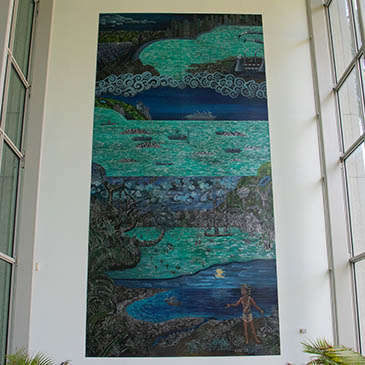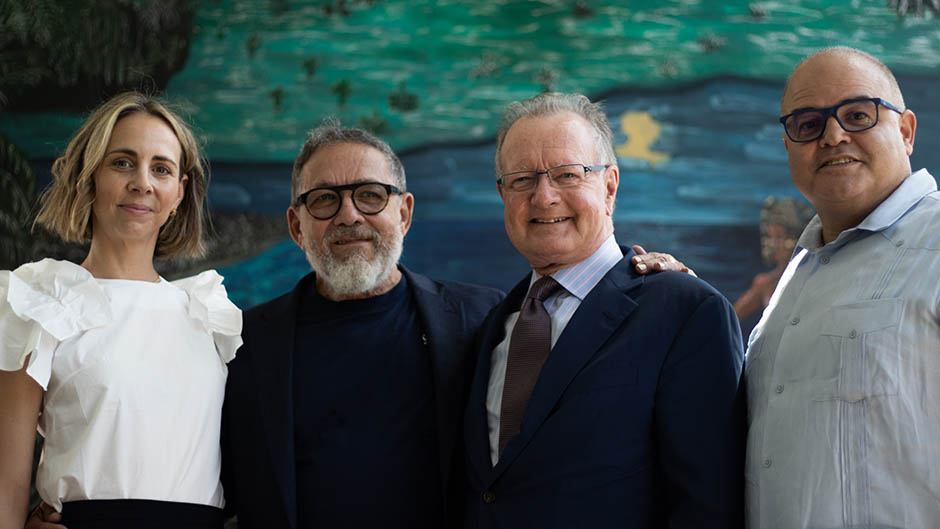Miami Herbert Business School’s Aresty Building lobby, a spacious and highly transited area framed by double-height glass panes, now also showcases regal wall art as part of the inviting entrance to the building’s main floors. A recently unveiled 20-foot piece by artist Edouard Duval-Carrie features mixed media on aluminum artwork forming rivers, towns, and people and depicting milestones, hardships, and successes that have shaped modern Florida.
On May 9, faculty, students, and guests gathered at the lobby for the unveiling, which opened with introductory remarks by Miami Herbert Dean John Quelch.
“It is important for people in business to develop an appreciation for art and the arts. Art is an essential part of humanity,” Quelch said at the presentation.
 The commissioned piece, named “The Floridas: A brief history,” represents a step forward in the dean’s vision to enhance the connection between art and business at Miami Herbert.
The commissioned piece, named “The Floridas: A brief history,” represents a step forward in the dean’s vision to enhance the connection between art and business at Miami Herbert.
“Whenever we acquire a stunning piece of art like this, we have the opportunity not only to celebrate a particular artist but also to look at something that we don’t immediately understand which drives us to ask more questions. That is an intellectual challenge that any business student should be able to embrace – not just with a balance sheet, but also with art,” he said.
Chosen to create a piece that is both enduring and educational, Duval-Carrie incorporated moments in time, including the first encounters with the region’s native population, the peninsula’s annexation in the early 1800s, the influx of investors from the north like Henry Flagler later in the century, and current coastal life and industries. The delicate ecosystem of the Everglades and ocean waterways permeate throughout the imagery. The piece also depicts the migrations that have impacted and molded the state.
The arrival of various peoples, especially to Miami, “has created for this part of the United States a unique multicultural environment,” Duval-Carrie said during his speech. “It is very important to me as an artist, when portraying something, to be exact and to present it in the most honest and respectful way possible.”
The exactitude includes the contrasts of the journeys to and from the state. At one point, we encounter the sight of cruise ships sailing towards the Caribbean islands while Haitians in rafts row towards the South Floridian shore.
Artist-in-residence and Miami Herbert alumnus Xavier Cortada, BA ’86, MPA/JD ’91, who introduced Duval-Carrie at the event, reflected on the juxtaposing scenes. “I see the tension that created Florida from its very origins, and through cultural interactions that continue over time to visit us today,” he said.
The artwork encapsulates toils and hopes in an almost mystical ambiance that connects history to spiritual undertones. In this manner, Duval-Carrie delivers an element of the surreal that has characterized his creations throughout a career that spans over three decades. Originally from Port-au-Prince, Haiti, he has lived in Puerto Rico, New York, Montreal, Paris, and – for the past 30 years – Miami. Exhibitions of his work have been included in galleries and museums in Europe and the Americas. Locally, his mixed media paintings, sculptures, and window art have been featured in locations like the Perez Art Museum, Museum of Contemporary Art in North Miami, and Miami International Airport. Since 2009, he presents the Global Caribbean Exhibit at Miami’s Art Basel.
The celebrated artist received the Ellie’s Award in 2018 and the Medal of Chevalier of the Order of Arts and Letters in France in 2016. He also helped found the Haitian Cultural Arts Alliance in Miami in 1994 and currently serves as its executive director.
His latest installation at Miami Herbert “brings that kind of global perspective to a global city,” Cortada described during his remarks.
As a final dimension of the piece, historic and surreal elements blend into a vastness of ocean, time, and space to suggest Florida’s continued possibilities.
“We wanted to capture not only the evolution of this particular place in the United States up to the present but also its potential,” Duval-Carrie stated.
At the conclusion of his speech, he expressed his appreciation for the opportunity. “I am elated,” he told attendees as his artwork graced the wall behind him, where it remains to permanently stimulate minds and adorn a main entryway to Miami Herbert Business School.

